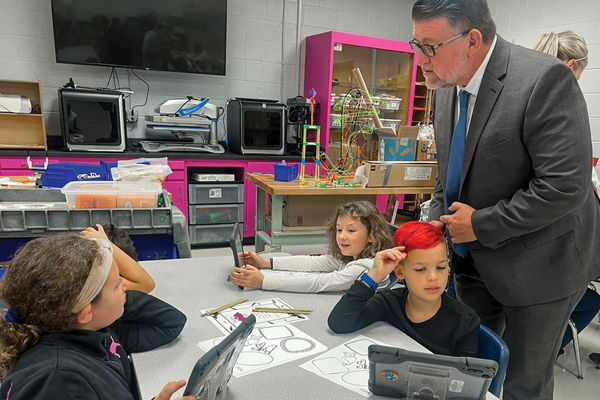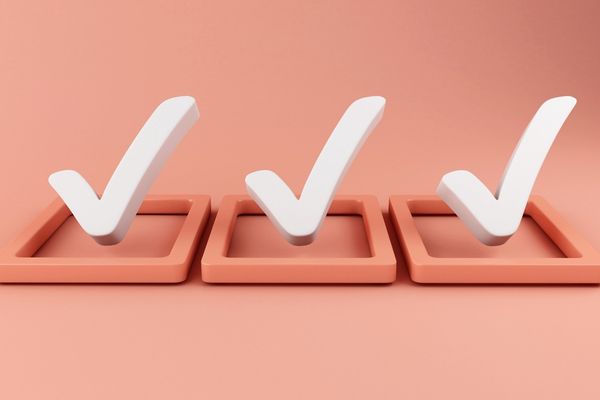Convergence of Digital Learning for Staff and Students Alike
March 01, 2023
AASA Learning 2025 Lighthouse Demonstration System: ELIZABETH FORWARD SCHOOLS
As the first school district in Pennsylvania to provide an iPad to each student at every grade level, the Elizabeth Forward system has spent years helping educators master the art of digital convergence with a modern learning framework that makes the most of a student-centered culture.
“Integrating technology to personalize learning — that’s really a powerful piece of the work that we do,” says Todd Keruskin, former superintendent of the 2,300-student school district in Allegheny County, which serves both rural and suburban communities outside Pittsburgh. “And that’s really how we define equity, which occurs when you meet the diverse needs of every student in the classroom.”
As an AASA-designated Lighthouse System, Elizabeth Forward showcases its strengths as a digital convergence leader, where the delivery of traditional curriculum with strong teaching skills is matched with the thoughtful and widespread use of emerging technology tools.
That’s where the iPads come in. In the hands of every student in kindergarten through grade 12 for the past 11 years, they have become essential in “breaking down the walls of the classroom,” says Keith Konyk, the district’s superintendent since January.
To illustrate, Konyk notes that three times a year educators use NWEA benchmark assessments based on national norms to gauge student standing. The data then are entered into various educational technology tools used to develop personalized learning plans, taking into account that a 2nd-grade student might be ready for 3rd-grade math or 4th-grade reading.
One such tool is eSpark Quest, which includes both direct instruction and practice activities, including videos, games, activities and quizzes. Students on their iPads engage with eSpark through the district’s Canvas learning management system.
“Once the kids engage in that technology tool, the tool gives us feedback, which gives us access to more relevant data as students work through their personalized learning paths,” Konyk says. “Our teachers are able to pull groups that have specific needs and work with them in small-group settings, which change every week based on the feedback received.”
Staff Learning
For sure, it takes informed teachers to work effectively in a district committed to digital convergence. Elizabeth Forward uses Modern Teacher learning modules to bring every teacher on board.
“You can’t do it all at once,” says Keruskin, now a vice president at McGraw Hill. “You can’t just put teachers in an auditorium or a library for six or eight hours and go over 120 slides.” The district started with cohorts of teachers selected for each school. Eventually, every teacher was involved using tools of technology to master their personalized professional development.
“What’s interesting is that the students log on to their learning system and the teachers log on to the same learning management system, with courses built for them that they can learn at their own pace,” Keruskin says.

Badges advance the learner-centered culture, which for kindergarten students entails roughly 70 badges for specific skills mastered. “When a kindergartener leaves with a grade of A, B, C or D, that doesn’t really tell you much about what they’re able to do,” Keruskin says. “But if you give them a badge that says this kid can count from one to 100 or that they can identify sight words, that’s more powerful information for the 1st-grade teacher to use and for the parent at home to understand.”
The district plans to expand badges through grade 12. Teachers, in their professional development, also accumulate badges, which amount to a form of micro-credentialing. “It’s pretty cool that we’re seeing badges work for kindergarteners and that it works as well for adult learners,” Keruskin says.
Accessible Tools
Back in the schoolhouse, every classroom develops a classroom vision generated by students at the start of the school year. Standard operating procedures, in view in every classroom, are put to use should three or four students ask the same question. And teacher-prepared “learning playlists” spell out exactly what each student will be working on that day and throughout the week.
“The nice thing about having digital tools is that there’s no longer a kid saying, ‘Hey, I can’t do my homework because I don’t have a worksheet,’ because that’s part of the playlist,” Keruskin says. “If there’s a kid in need of remediation or a refresher tool, there’s a video to watch to help them along.”
The tools are available as well for parents to use with their children at home, and that’s the power of the digital classroom, which became even more apparent during the coronavirus pandemic.
“Those tools that we put in place for COVID across the country, that just wasn’t about providing pandemic learning tools. That really is about the future of education,” Keruskin says. “Years ago, there were limitations with software and how to implement and change teaching and instructional strategies, but we jumped off the cliff and went for it. We realized that with technology, kids can learn anytime, anywhere, and that was the shift we wanted to embrace.”
Linda Chion Kenney is a freelance education writer in Lithia, Fla.
Author
Roster of Lighthouses
To read the full list of Lighthouse school systems being featured in this series and learn more about becoming a demonstration district, visit aasa.org/learning2025.
Advertisement
Advertisement
Advertisement
Advertisement




